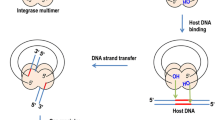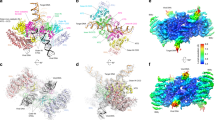Abstract
Phage ΦC31 integrase-mediated gene delivery is believed to be safer than using retroviral vectors since the protein confines its insertion of the target gene to a limited number of sites in mammalian genomes. To evaluate its safety in human cells, it is important to understand the interactions between this integrase and cellular proteins. Here we show that ΦC31 integrase interacts with TTRAP as presented by yeast two-hybrid and co-immunoprecipitation assays. Reducing the expression of endogenous TTRAP can increase the efficiency of ΦC31 integrase-mediated integration. A possible effect of interaction between ΦC31 integrase and TTRAP was highlighted by the fact that ΦC31 integrase inhibited the NFκB activation mediated by IL-1 in a dose-dependent manner. Because low dose of ΦC31 integrase can mediate considerable recombination events, we suggest that low dose of ΦC31 integrase be used when this integrase is applied in human cells.




Similar content being viewed by others
References
Hacein-Bey-Abina S, von Kalle C, Schmidt M, Le Deist F, Wulffraat N, McIntyre E, Radford I, Villeval JL, Fraser CC, Cavazzana-Calvo M, Fischer A (2003) A serious adverse event after successful gene therapy for X-linked severe combined immunodeficiency. N Engl J Med 348:255–256
Groth AC, Olivares EC, Thyagarajan B, Calos MP (2000) A phage integrase directs efficient site-specific integration in human cells. Proc Natl Acad Sci USA 97:5995–6000
Kuhstoss S, Rao RN (1991) Analysis of the integration function of the Streptomycete bacteriophage-phi-C31. J Mol Biol 222:897–908
Smith MCM, Thorpe HM (2002) Diversity in the serine recombinases. Mol Microbiol 44:299–307
Thorpe HM, Smith MCM (1998) In vitro site-specific integration of bacteriophage DNA catalyzed by a recombinase of the resolvase/invertase family. Proc Natl Acad Sci USA 95:5505–5510
Chalberg TW, Portlock JL, Olivares EC, Thyagarajan B, Kirby PJ, Hillman RT, Hoelters J, Calos MP (2006) Integration specificity of phage phi C31 integrase in the human genome. J Mol Biol 357:28–48
Belteki G, Gertsenstein M, Ow DW, Nagy A (2003) Site-specific cassette exchange and germline transmission with mouse ES cells expressing phi C31 integrase. Nat Biotechnol 21:321–324
Calos MP (2006) The phi C31 integrase system for gene therapy. Curr Gene Ther 6:633–645
Groth AC, Fish M, Nusse R, Calos MP (2004) Construction of transgenic Drosophila by using the site-specific integrase from phage phi C31. Genetics 166:1775–1782
Thyagarajan B, Olivares EC, Hollis RP, Ginsburg DS, Calos MP (2001) Site-specific genomic integration in mammalian cells mediated by phage phi C31 integrase. Mol Cell Biol 21:3926–3934
Gupta M, Till R, Smith MCM (2007) Sequences in attB that affect the ability of theta C31 integrase to synapse and to activate DNA cleavage. Nucleic Acids Res 35:3407–3419
Rowley PA, Smith MCA, Younger E, Smith MCM (2008) A motif in the C-terminal domain of phiC31 integrase controls the directionality of recombination. Nucleic Acids Res 36:3879–3891
Smith MCA, Till R, Brady K, Soultanas P, Thorpe H, Smith MCM (2004) Synapsis and DNA cleavage in phi C31 integrase-mediated site-specific recombination. Nucleic Acids Res 32:2607–2617
Ehrhardt A, Yant SR, Giering JC, Xu H, Engler JA, Kay MA (2007) Somatic integration from an adenoviral hybrid vector into a hot spot in mouse liver results in persistent transgene expression levels in vivo. Mol Ther 15:146–156
Olivares EC, Hollis RP, Chalberg TW, Meuse L, Kay MA, Calos MP (2002) Site-specific genomic integration produces therapeutic factor IX levels in mice. Nat Biotechnol 20:1124–1128
Quenneville SP, Chapdelaine P, Rousseau J, Beaulieu J, Caron NJ, Skuk D, Mills P, Olivares EC, Calos MP, Tremblay JP (2004) Nucleofection of muscle-derived stem cells and myoblasts with phi C31 integrase: stable expression of a full-length-dystrophin fusion gene by human myoblasts. Mol Ther 10:679–687
Thyagarajan B, Liu Y, Shin S, Lakshmipathy U, Scheyhing K, Xue H, Ellerstrom C, Strehl R, Hyllner J, Rao MS, Chesnut JD (2008) Creation of engineered human embryonic stem cell lines using phiC31 integrase. Stem Cells 26:119–126
Ehrhardt A, Engler JA, Xu H, Cherry AM, Kay MA (2006) Molecular analysis of chromosomal rearrangements in mammalian cells after phi C31-mediated integration. Hum Gene Ther 17:1077–1094
Liu J, Jeppesen I, Nielsen K, Jensen TG (2006) Phi c31 integrase induces chromosomal aberrations in primary human fibroblasts. Gene Ther 13:1188–1190
Chen JZ, Ji CN, Xu GL, Pang RY, Yao JH, Zhu HZ, Xue JL, Jia W (2006) DAXX interacts with phage phi C31 integrase and inhibits recombination. Nucleic Acids Res 34:6298–6304
Gao J, Duan B, Wang DG, Deng XH, Zhang GY, Xu L, Xu TL (2005) Coupling between NMDA receptor and acid-sensing ion channel contributes to ischemic neuronal death. Neuron 48:635–646
Pype S, Declercq W, Ibrahimi A, Michiels C, Van Rietschoten JGI, Dewulf N, de Boer M, Vandenabeele P, Huylebroeck D, Remacle JE (2000) TTRAP, a novel protein that associates with CD40, tumor necrosis factor (TNF) receptor-75 and TNF receptor-associated factors (TRAFs) and that inhibits nuclear factor-kappa B activation. J Biol Chem 275:18586–18593
Pei HP, Yordy JS, Leng QX, Zhao QH, Watson DK, Li RZ (2003) EAPII interacts with ETS1 and modulates its transcriptional function. Oncogene 22:2699–2709
Andreas S, Schwenk F, Kuter-Luks B, Faust N, Kuhn R (2002) Enhanced efficiency through nuclear localization signal fusion on phage phi C31-integrase: activity comparison with Cre and FLPe recombinase in mammalian cells. Nucleic Acids Res 30:2299–2306
Xu GL, Pan YK, Wang BY, Huang L, Tian L, Xue JL, Chen JZ, Jia W (2008) TTRAP is a novel PML nuclear bodies-associated protein. Biochem Biophys Res Commun 375:395–398
Acknowledgments
We are very grateful to Michele P. Calos for providing the pCMV-Int plasmid. We also thank Shen Q. for her technical support. This work was supported by the National Basic Research Program of China (973, 2004CB518803), State High Technology Development Program (863, 2007aa021002 and 2006aa02Z161) and Nature Science Fund (30771236).
Author information
Authors and Affiliations
Corresponding authors
Rights and permissions
About this article
Cite this article
Wang, By., Xu, Gl., Zhou, Ch. et al. ΦC31 integrase interacts with TTRAP and inhibits NFκB activation. Mol Biol Rep 37, 2809–2816 (2010). https://doi.org/10.1007/s11033-009-9829-3
Received:
Accepted:
Published:
Issue Date:
DOI: https://doi.org/10.1007/s11033-009-9829-3




